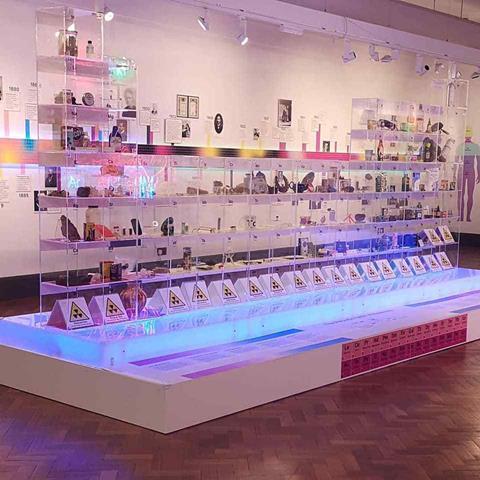Bolton Museum
Open until 26 January 2020
Further information: www.boltonlams.co.uk/whats-on/2414/elements-exhibition-bolton-museum
Put together by an in-house team, this exhibition to celebrate the International Year of the Periodic Table certainly has a ‘wow factor’. Visitors are welcomed by Tom Lehrer singing The Element Song. When Lehrer wrote it in 1959, there were only 102 elements, although he predicted that elements beyond nobelium would soon be created. Text panels along the walls introduce visitors to the concept of the periodic table and its discovery. While the 1869 publication of Dmitri Mendeleev’s periodic table is well known, the text reminds readers that Julius Lothar Meyer’s 1864 work should not be forgotten.
Nobel laureate Harry Kroto – educated in Bolton and of fullerene fame – is remembered in a showcase explaining the allotropes of carbon. Along an entire wall of the temporary exhibition gallery is a timeline highlighting the discovery of each element. The elements are arranged by atomic number and sit alongside the names of their discoverers (and their portraits in some cases).
At the far end of the gallery, there are several elements-related games to play. Younger visitors can play dress-up in the lab coats and goggles provided.

Without a doubt, the main attraction is a home-constructed display in the centre of the gallery. It consists of 90 transparent plastic cubes (actinides and lanthanides have just one box each) in the exact shape of the periodic table.
Objects inside the boxes showcase each element’s uses and applications, some of which were new to me. There’s a banana for selenium, neon lights, europium-containing Euro bank notes and neodymium magnets. The exhibition explains that the human body requires about 60 of these elements to work effectively.
I think the exhibition is useful to introduce anyone to the subject. Children are especially welcome. Even complex topics like atomic theory and particle physics are explained in simple language. But scientists would be very interested to see this exhibition, too, and could easily spend an hour here. To round off the visit, the museum shop has on sale books, jigsaws, mugs, pencil cases, candy and, of course, posters devoted to the theme.
The Elements is a work of art, and I hope it can be given a permanent space somewhere.












No comments yet